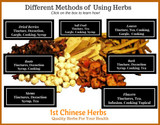Herbal Information on Stephania Root Single Herb Extract Granules 10:1
Common Name: Stephania Root
Channels/Meridians: Spleen, Kidney, Bladder
Pin Yin Name: Han Fang Ji, Fang Ji
Botanical Name: Stephania tetrandrae Root
Latin Name: Radix Stephaniae Tetrandrae
Other Ingredients: A minimal amount of dextrin may have been added to adjust the extraction ratio to 10:1 and to enhance stability.
Package Size: 100 grams
Form: Extract Granules 10:1
Dosage: Take 0.5 g each time, 1 to 2 times per day, or as instructed by a herbal practitioner.
Origin: China
Brand: Activeherb Single Herb Extract Granule
Cautions: Do not use if pregnant or nursing. This is not to be made into an eye wash. It is a concentrated extract, not the raw root.
 Additional Information on Stephania Root
Additional Information on Stephania Root
Han Fang Ji / Fang Ji has been used for centuries in traditional Chinese Medicine and has a wide range of beneficial properties. It has therapeutic benefits for several medical conditions.
Modern studies have shown that Stephania Root contains Tetrandrine, a Bisbenzylisoquinoline Alkaloid. This is the alkaloid that gives Stephania Root its potency.
Benefits of Stephania Root
Han Fang Ji, also known as Stephania tetrandra, is a traditional Chinese medicinal herb that has been widely used for centuries. It is valued for its various therapeutic properties and is commonly employed in traditional Chinese medicine (TCM) to treat a range of health conditions. Here are ten benefits associated with the use of Han Fang Ji:
Anti-inflammatory effects: Han Fang Ji contains bioactive compounds that possess potent anti-inflammatory properties. These compounds help to reduce inflammation in the body, providing relief from conditions such as arthritis, rheumatism, and gout.
Analgesic properties: The herb has analgesic (pain-relieving) effects, making it beneficial for managing pain associated with inflammatory conditions, muscle strains, and injuries.
Diuretic action: Han Fang Ji has diuretic properties, which means it promotes increased urine production and helps to eliminate excess water and toxins from the body. This action can be beneficial in reducing edema (swelling) and relieving conditions such as water retention and urinary tract infections.
Anti-hypertensive effects: Studies have shown that Han Fang Ji may have antihypertensive effects, meaning it can help lower high blood pressure levels. This can be advantageous for individuals with hypertension, reducing the risk of cardiovascular complications.
Antipyretic properties: Han Fang Ji has been traditionally used as an antipyretic agent, aiding in the reduction of fever. Its cooling properties can help alleviate symptoms associated with febrile conditions.
Immunomodulatory effects: The herb has been found to exhibit immunomodulatory effects, meaning it can help regulate and balance the immune system. This property can be valuable in conditions where the immune system is overactive or compromised.
Antimicrobial activity: Han Fang Ji possesses antimicrobial properties and has shown effectiveness against certain bacteria, viruses, and fungi. It may be used as an adjunct in the management of infectious diseases.
Hepatoprotective effects: Research suggests that Han Fang Ji may have hepatoprotective effects, protecting the liver from damage caused by toxins or diseases. It may help enhance liver function and support liver health.
Anticancer potential: Preliminary studies indicate that Han Fang Ji extracts may exhibit anticancer activities. Further research is required to understand the mechanisms involved and to explore its potential as an adjunct in cancer treatment.
Anti-allergic effects: Han Fang Ji has been traditionally used to alleviate allergic reactions and symptoms. Its anti-allergic properties may help reduce the severity of allergic conditions such as asthma, eczema, and hay fever.
It is important to note that while Han Fang Ji offers potential benefits, it should be used under the guidance of a qualified healthcare practitioner, especially in combination with any ongoing treatments or medications. Proper dosage, administration, and individual suitability should be considered to ensure safe and effective use.
- Induces diuresis to alleviate edema
- Eliminate Stagnant Bronchial Mucous
- Expels Wind to alleviate pain
- Recommended by Stephen Buhner in his book for Lyme Disease
Product Properties: Bitter in Taste, Acrid, Very Cold
Naturally Occurring Components in Stephania Root: Tetrandrine or Hanfangchin A, Fangchinoline (Hanfangchin B or Demethyl tetrandrine), Hanfangchin C, Menisine, Menisidine, Cyclanoline, Oxofangchirine, stephanthrine, glycosides, phenols, organic acids
Key functions of the Root - Expelling Wind.
Extract granules at 5x concentration 100 g (3.53 oz). GMP Certified. At a final 10:1 concentration, 100 g granules is equal to 1000 g (2.2 lb) dried herb. This product contains no preservatives, no alcohol, no artificial flavor or color, no gluten, and no pharmaceuticals. A minimal amount of dextrin may have been added to adjust the extraction ratio to 10:1 and to enhance stability. Extract granules are easy to use, just add hot water. No brewing time, nor straining. Pour the hot water over the granules and stir.
Why choose ActiveHerb granules?
- Optimized herb
- Active ingredients are full spectrum
- Will not clump, so no waste
- Each batch tested for heavy metals
- Competitive pricing
- GMP Certified
Most comprehensive and stringent testing standard.
ActiveHerb are the only company whose granules are free of 278 pesticides and herbicides. These test results, along with other tests such as that for heavy metals, are provided in the Certificate of Analysis (COAs) for each item and every batch.
References:
http://www.planetthrive.com/?s=stephania+root&x=0&y=0
http://buhnerhealinglyme.com/herbs/eye-decoction/
Healing Lyme Disease by S. Buhner
The Natural Health Dictionary: Your Comprehensive A-Z Guide for Healing by Dr. Mao Shing Ni






















